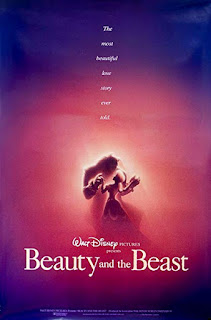On this day, in 1991, Walt Disney Picture's 30th animated feature, Beauty and the Beast, was released at the El Capitan Theatre. The movie had kind of had a premier a month and a half earlier at the New York Film Festival, it just wasn't finished yet. Even the roughly animated sequences were pretty impressive, though. Based on a French fairy tale by Jeanne-Marie Leprince de Beaumont (try saying that five times fast),
Beast is the third film of the Disney Renaissance and considered by some to be the pinnacle of modern Disney animation (I'm biased towards
The Lion King for that title, but I do think
Beast is a very close second).
When
Snow White and the Seven Dwarfs successfully proved that audiences were willing to sit through a feature length cartoon, Walt began looking around for other stories to animate. One of the ones that looked promising was the tale of
Beauty and the Beast. The Disney writers wrestled with the story throughout the Thirties and even into the Fifties before deciding it was too difficult to adapt. To complicate matters, French director Jean Cocteau released a now classic version of the story in 1946. Plans for a Disney version ended up being shelved, where they gathered dust for decades.
In the late Eighties, after the making of
Who Framed Roger Rabbit?, Disney had a new animation group in England that needed a new project to work on.
Beauty and the Beast was dusted off and put into production as a non-musical. When Jeffrey Katzenberg, then chairman of the studio, saw an early storyboard treatment in 1989, the kindest thing he could say was throw it all away and let's start over. With the success of
The Little Mermaid, Jeffrey declared that the new
Beast would be a musical and put Alan Menken and Howard Ashman on the job. He wanted the directors of
Mermaid, Ron Clements and John Musker, to lead the group again but they were too worn out to accept. Believe it or not, the studio then turned to two guys who had never directed a feature film before, Kirk Wise and Gary Trousdale. What Kirk and Gary had done was direct a little attraction for Epcot called
Cranium Command.
Initially, the studio considered casting Jodi Benson, who helped make
The Little Mermaid such a success, as Belle. They quickly decided, however, that this Disney heroine needed to sound more like a grown woman than a teenager and looked at over 500 actresses for the role. Howard Ashman, who was also an executive producer on the film, favored an actress featured on the cast recording of
Show Boat and Broadway stalwart Paige O'Hara was given the part. To add some tragedy to the proceedings, Howard learned that he was dying from AIDS and so the pre-production hub moved from London to New York to accommodate his failing health. He would never get to see a finished film as he passed away eight months before
Beast's release.
Most of the animation was done at the main studio in California although some was produced at the Disney-MGM Studios in Orlando, specifically the "Be Our Guest" scene.
Beast is the second movie, after
The Rescuers Down Under, that was done using the Computer Animation Production System (CAPS), a digital process of scanning and inking drawings that allowed for greater depth and a more colorful finished product then the xerography technique the studio had used since the early Sixties. The music was mostly recorded with the actors singing at the same the orchestra played, instead of the usual practice of having the voice talent sing to a recording, thus giving Alan and Howard's songs a big boost of energy. And talk about voice talent. In addition to Paige, the cast includes Robby Benson, Jerry Orbach, David Ogden Stiers, Jo Anne Worley, Tony Jay, Richard White and Disney Legend Angela Lansbury.
Upon its release,
Beauty and the Beast was a massive success. It was the first animated film to gross 100 million dollars in North America and grossed over 350 million worldwide.
Beast was universally acclaimed by critics and still boasts a rare A+ rating from audiences today. It became the first animated film to win the Golden Globe for Best Musical or Comedy. When Oscar time rolled around,
Beast garnered six nominations: three for Best Song ("Beauty and the Beast" would win), Best Original Score (also a win), Best Sound and, another first for an animated movie, Best Picture. It would also win several Grammy Awards, including one for Celine Dion and Peabo Bryson's pop version of "Beauty and the Beast." Beast was added to the National Film Registry in 2002.
Since 1991,
Beauty and the Beast has spawned all manner of offspring. A hit Broadway musical opened in 1994 and ran for 13 years. Some version of that show is still running somewhere in the world. There have been several direct-to-video sequels, the most successful of which was
The Enchanted Christmas. Multiple shows have appeared over the years in Disney's theme parks, the Florida ones in particular, and there might have been a live action version released at some point. All of which just goes to prove that when you have a tale as old as time, and you give it the respect it deserves, fans will love it for all of time.


















































